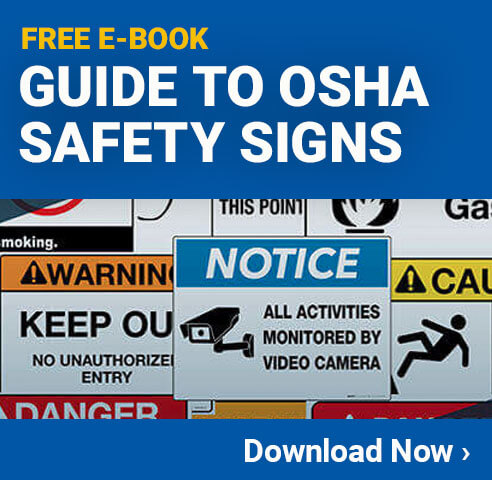
Text From Infographic
Pipe Marking 101 - Why is pipe marking important?
- Safety - Eliminate accidents by minimizing identification errors.
- Efficiency - No wasted time tracing pipes to their source.
- Compliance - Reduce company liability and eliminate fines.
Guidelines for labeling pipes
There are four main arenas of pipe marking guidelines.
-
Format - Standards and Formats vary from country to country.
- EU Standard
- Marine/Offshore (ISO 14726)
- U.S. Standard (AMSE/ANSI Standard Standard A13.1-2007)
Numbers 2 through 4 focus on the U.S. Standard
-
Color Scheme - Color schemes help with classification
Pipe Marking labels must effectively communicate the contents of the pipes, and give additional detail if special hazards (such as extreme temperatures or pressures) exist.- White on Green - All Water (Potable, Cooling, Boiler, etc.)
- White on Blue - All Air (Compressed, Lab, etc.)
- Black on Yellow - Flammable Fluids & Gasses
- White on Red - Fire-Quenching Fluids
- White on Brown - Combustible Fluids & Gasses
- Black on Orange - Toxic/Corrosive Fluids & Gasses
- White on Purple - Acids & Alkalis
- White on Black - Waste Media
- White on Gray - Non flammable Gas
- Black on White - Air Ventilation Systems
-
Height of the text - The height of the text is based on the pipe size
Text height and pipe marker label lengths should follow these recommended guidelines:Pipe Outer Diameter Text Height Minimum Label Length 0.75" - 1.24" 0.5" 8" 1.25" - 2.4" 0.75" 8" 2.5" - 7.9" 1.25" 12" 8" - 9.9" 2.5" 24" 10"+ 3.5" 32" -
Visibility - Pipe markers should be visually accessible upon entering the area.
- Guideline #1 - Pipes should be marked as close to all valves or flanges as possible.
- Guideline #2 - Pipes should be marked as close to directional changes as possible.
- Guideline #3 - Pipes should be marked at points where they have penetrated walls or dividers.
- Guideline #4 - Pipes should be marked every 25’ to 50’ interval on straight runs.
- Guideline #5 - Pipe markers should be readily visible when entering the facility from the normal entry point.
Creative Safety Supply is committed to being your safety and labeling experts. We provide a wide range of industrial safety products, including made-to-order pipe markers and industrial pipe marking label printers so you can make your pipe markers in-house. Call today!
Similar Infographics
- 5 Steps for Pipe Label Compliance
- Stop Buying Labels from a Catalog
- The NFPA 704 Diamond Explained
- The A,B,Cs and 1,2,3s of Fall Protection
- The Importance of Industrial Label Printers
- Marking Floors to Communicate Social Distancing
- The 12 Days of Christmas Safety
- Surprise OSHA Inspection? What to Expect
- Tool Organization with Foam Kits


